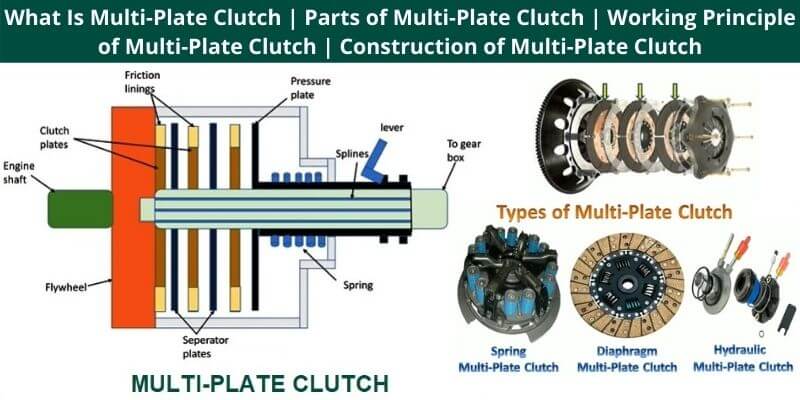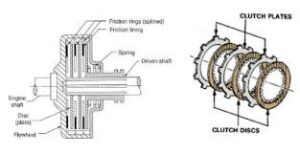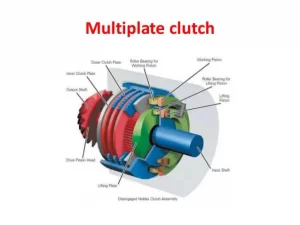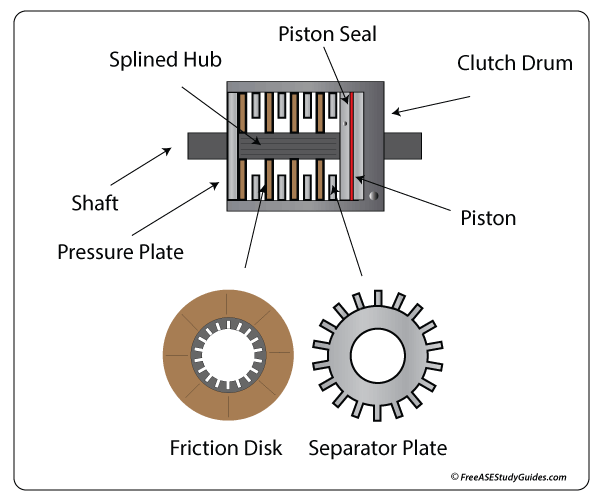
What is clutch?
Clutch is a device used in the transmission system of a moter vehicle to engage and disengage the Power transmission thuas the clutch is located between the engine and the transmission when the clutch is engaged the power flow from the engine to the rear wheels through the transmission system and the vehicle moves when the clutch is disengaged the power is not transmitted to the rear wheels and the vehicle stop while the engine still running.
Clutch is a mechanical device that connects and disconnects the power transmission between the driving shaft and the driven shaft.
Here the driving shaft is the one that is getting the power from the engine i.e. the engine is rotating and the driven shaft is the one on which the vehicle moves and between these comes the clutch which connects and disconnects these two shafts.
What Is Multi Plate Clutch?
The Multi Plate Clutch uses multiple clutch plates to make contact with the engine flywheel to transfer power between the engine shaft and the transmission shaft. A multi-plate clutch used in automobiles and machinery where high torque output is required.
It is a type of clutch that transmits more power from the engine to the transmission shaft of an automobile vehicle and also, makes up for the torque loss due to slippage. Multiple clutches consist of more than three discs or plates so that they can provide more torque output.
Multi-plate clutches are used in heavy vehicles with racing cars and motorcycles for transmitting high torque. As compared to single plate clutches, these are smooth and easy to operate due to their assembly of friction surface’s contact. It may be used where the space is very limited.
Clutch Material
There are so many materials that have been used for making the clutch plates.
Semi-Metallic Materials: This type of material contains 30% to 65% of steel, iron, and copper. These clutches have high heat resistance and are hard to break and those are durable enough. The plates are reliable but not that good for high-speed operation.
Organic Materials: These are the most common type of materials that we used the most. These materials clutches are capable of all kinds of usage in a variety of vehicles such as size. This material contains high copper content because that it can transfer heat effectively.
Ceramic Materials: These types of clutches contain organic and inorganic materials at the same time which include glass, rubber, Kevlar, and carbon materials. In this clutch, the coefficient of the friction is relatively high which lies between 0.33 to 0.4. In most the intense applications, this type of clutch is used, like in trucks and racing cars.
Multi-Plate Clutch Diagram
Parts Of Multi Plate Clutch
The components of all the clutches used in automobile vehicles are almost the same. But with some modifications, so let’s discuss the main parts of different types of multi-plate clasps used.
- Pressure Plate
- Clutch Plate
- Thrust Spring
- Clutch Paddle
- Inner Splined Sleeves
- Flywheel
- Diaphragm Spring
- Pressure Plate: A plate attached to the splined sleeves which further connected to the pedal fulcrum. Such that when the clutch pedal pressed, the sleeves attached to the pedal fulcrum move outward, which in turn drives the pressure plate attached with this splined sleeve.
- Clutch Plate: It is a metallic plate having frictional lines at its outer surfaces. It uses frictional contact with the flywheel to transmit power between the engine shaft and the transmission shaft.
- Thrust Springs: These are springs used behind the pressure plate, and the stiffness of these springs is used by the pressure plate to maintain frictional contact with clutch plates, which in turn supports the clutch engagement.
- Clutch Pedal: A clutch pedal operated by the driver of the vehicle used to control the engagement and disengagement of the clutch.
- Splined Shaft & Inner Splined Sleeves: An outer splined transmission input shaft over which the complete clutch assembly. That includes clutch plates, pressure plates, inner splined sleeve, the clutch casing place and rotates with it.
- Flywheel: It is part of the engine. We can also consider it as part of the clutch system as the transmission of power from the engine output shaft to the transmission shaft obtain by the frictional contact between a clutch and the flywheel of an engine.
- Diaphragm Spring: In the diaphragm type clutch system, the thrust springs used in the spring type clutch replace with a single diaphragm type spring.
Types Of Multi-Plate Clutch
These are various types of Multi-plate Clutches
- Spring Type Multi Plate Clutch
- Diaphragm Type Multi Plate Clutch
- Hydraulic Operated or Automatic Transmission Clutch
- Wet Multi Plate Clutch
- Dry Multi Plate Clutch
1. Spring Type Multi Plate Clutch
Spring Type Multi-Plates Clutching the clutch, a cover attaches with a flywheel of engine use inside which the multiple clutch plates, pressure plates, thrust bearing, etc. packed. The clutch plates place over each other and mount over a splined shaft.
2. Diaphragm Type Multi Plate Clutch
It is the modified version of the spring-type multi-plates clutch. In which the thrust springs places circularly from the spring type clutch replace with a special crown-shape finger type spring called diaphragm spring.
3. Hydraulic Operated Or Automatic Transmission Clutch
It is the modern type of clutches uses in vehicles fitted with automatic transmission, in this type of clutches a hydraulic device having highly compressed fluid operates with the accelerator pedal coupled with the multi-plate clutches.
The engagement and disengagement of the clutch obtained by the output given by the hydraulic device, which controls with the acceleration pedal.
4. Wet Multi Plate Clutch
Wet clutches, in general, have multiple clutch plates (in cars) and have a supply of oil to lubricate and cool the components. This type of clutch is located inside the engine casing.
The wet clutches are greatly amplified and therefore can cope with much higher torque inputs. Wet clutches are generally smaller in size.
The noise level in wet clutches is less when compares to dry clutches. The presence of oil between plates helps in managing the noise.
Wear and tear are very much less in the wet clutch. In a wet clutch, the lubricating oil keeps surfaces clean and provides smoother performance and longer life.
Wet clutches provide a better coefficient of friction, as the surface area increases due to the presence of multiple plates.
5. Dry Multi Plate Clutch
A Dry Clutch is a type of clutch that is not bathed in liquid (oil) and uses friction to engage. This type of clutch has its plate outside the engine casing. Usually, the dry clutch is larger to increase the surface area of the friction plate for optimal air cooling because it does get hot due to friction of the plate.
The level of noise in the dry clutch is more and keeps increasing as the clutch continues to undergo wear and tear.
Dry clutches have a single frictional surface to transmit the power between two plates. Therefore, they do not have a much better coefficient of friction.
In the dry clutch, the lubricant does not applies and hence the torque transmitting of these clutches is better. Dry clutches do not have an oil supply and are generally single-plate.
Application Of Multi-Plate Clutch
- It can be used in industrial machines and automobiles where high performance is required.
- Due to the compact gearbox and high acceleration is required and the criteria for torque transfer are maximum, it can be used in motorcycle or drag racing races, as well as in F1 vehicles.
- Due to the compact gearbox design, it can be used in ships, trucks, and locomotives.
- It is suitable for heavy types of machines such as bulldozers, excavators, tanks and caterpillars, and others because the multi-disc clutch is heavy and produces high power. Because of this, the heavy machine parts easily lift heavyweights.
- The multi-plate lock is used in heavy commercial vehicles to transmit high torque.
- The multi-disc clutch is used where the required space in which the clutch has to be installed is much less than with motorcycles and scooters.
Advantages & Disadvantages Of Multi-Plate Clutch
Advantages Of Multi-Plate Clutch
- Since the multi-plate clutches consist of more clutch plates, the ability to transmit the torque is quite high.
- This type of clutch is small. Due to its compact size, the multi-disc clutch is suitable for all types of vehicles around the globe. Since the motorcycles and scooters only have limited space, the multi-plate clutch can be easily installed due to its compact size.
- Compared to the single-disc clutch, the diameter of the multi-disc clutch is smaller than that of the single-disc clutch. Because of this function, the multi-disc clutch can be used in many sports such as racing and others.
- The multi-plate clutches have many friction surfaces. Since the torque transmission depends on the number of friction surfaces, the torque is higher with the multi-disc clutch than with the single-disc clutch.
- Because of the advantage of a higher torque rate, the multi-plate clutches can easily be used in heavy vehicles which are mainly used for commercial purposes.
- Compared to a single-disc clutch, the multi-disc clutch helps the engine achieve better acceleration.
- A force is required to depress the clutch pedal to make the clutch operational. Less pedal force is required to operate a multi-plate clutch.
Disadvantages Of Multi-Plate Clutch
- The weight of the multi-plate clutch is heavy and therefore not suitable for all-time use.
- The cost of the multi-plate clutch, along with its maintenance work, is very high. So it is not good for the multi-plate clutch users on a budget.
- Users have to spend additional money on the cooling medium. Because of this disadvantage, the maintenance cost automatically becomes high.
- They heat up quickly.
- Multi-plate clutches are heavy.
- Multi-plate clutches are too expensive



[…] Clutch […]
[…] Multi-Plate Clutch […]
welcome, fine blog on unctuous loss. similar helped.
good day, regal blog on blubbery loss. equivalent helped.